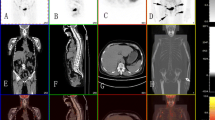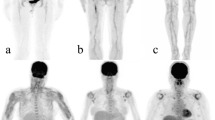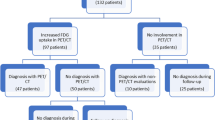Abstract
Purpose
To explore the 18F-fluoro-dexoxyglucose positron emission tomography/computed tomography (18F-FDG PET/CT) imaging characteristics of adult-onset Still’s disease (AOSD) and its significance in differential diagnosis from other connective tissue diseases (CTDs).
Methods
FDG PET/CT images of 54 patients with AOSD and 66 with other CTD from patients suffering from fever of unknown origin (FUO) were retrospectively studied and compared with 40 healthy controls. Clinical and PET/CT characteristics of AOSD and other CTDs were compared, and SUVmax (maximum standardized uptake value) was used to analyze the differences of FDG uptake in the blood pool, liver, spleen, bone marrow, and hyperplastic lymph nodes between the AOSD and other CTDs. The SUVmax ratios of the spleen, bone marrow, and lymph nodes to the liver were used to establish the diagnostic criteria for differential diagnosis of AOSD, and its diagnostic efficiency was evaluated.
Results
Positive findings are presented in 53/54 (98.1%) AOSD patients and 61/66 (92.4%) other CTD patients in PET/CT imaging. AOSD manifested as diffusely increased FDG uptake in the spleen and bone marrow, and multiple reactive hyperplasia lymph nodes are symmetrically distributed mainly in the neck and axilla, while other organs were seldom involved. Although these abnormalities could be seen in other CTDs, its incidence and uptake value were both higher in AOSD. If two or more of the following three standard were met, the sensitivity, specificity, and accuracy of diagnosing AOSD could reach 90.7%, 92.4%, and 91.7%, respectively: ① spleen SUVmax/liver SUVmax ≥ 1.2 and/or bone marrow SUVmax/liver SUVmax ≥ 1.4; ②symmetrically distributed reactive hyperplastic lymph nodes mainly in the neck and axilla with a lymph node SUVmax/liver SUVmax ≥ 1.8; and ③ no other abnormal uptake found in other organs.
Conclusion
Characteristic manifestations in AOSD were found on FDG PET/CT. These findings could help to identify AOSD from the other CTDs, especially in cases of fever of unknown origin, where it can assist in identifying the cause.
Key Points • Image characteristics of FDG PET/CT in adult-onset Still’s disease were described. • FDG PET/CT helps in identifying adult-onset Still’s disease from the other connective tissue diseases. • FDG PET/CT imaging standard for diagnosing adult-onset Still’s disease were established. |



Similar content being viewed by others
References
Yamaguchi M, Ohta A, Tsunematsu T, Kasukawa R, Mizushima Y, Kashiwagi H, Kashiwazaki S, Tanimoto K, Matsumoto Y, Ota T (1992) Preliminary criteria for classification of adult Still's disease. J Rheumatol 19:424–430
Cush JJ, Medsger TA Jr, Christy WC, Herbert DC, Cooperstein LA (1987) Adult-onset Still's disease. Clinical course and outcome. Arthritis Rheum 30:186–194
Wenter V, Muller JP, Albert NL, Lehner S, Fendler WP, Bartenstein P et al (2016) The diagnostic value of [(18)F]FDG PET for the detection of chronic osteomyelitis and implant-associated infection. Eur J Nucl Med Mol Imaging 43:749–761. https://doi.org/10.1007/s00259-015-3221-4
Kubota K, Yamashita H, Mimori A (2017) Clinical value of FDG-PET/CT for the evaluation of rheumatic diseases: rheumatoid arthritis, polymyalgia rheumatica, and relapsing polychondritis. Semin Nucl Med 47:408–424. https://doi.org/10.1053/j.semnuclmed.2017.02.005
Li Y, Zhou Y, Wang Q (2017) Multiple values of (18)F-FDG PET/CT in idiopathic inflammatory myopathy. Clin Rheumatol 36:2297–2305. https://doi.org/10.1007/s10067-017-3794-3
Curiel R, Akin EA, Beaulieu G, DePalma L, Hashefi M (2011) PET/CT imaging in systemic lupus erythematosus. Ann N Y Acad Sci 1228:71–80. https://doi.org/10.1111/j.1749-6632.2011.06076.x
Wang Q, Li YM, Li Y, Hua FC, Wang QS, Zhang XL, Cheng C, Wu H, Yao ZM, Zhang WF, Hou QY, Miao WB, Wang XM (2019) (18)F-FDGPET/CT in fever of unknown origin and inflammation of unknown origin: a Chinese multi-center study. Eur J Nucl Med Mol Imaging 46:159–165. https://doi.org/10.1007/s00259-018-4121-1
Andrews J, Al-Nahhas A, Pennell DJ, Hossain MS, Davies KA, Haskard DO et al (2004) Non-invasive imaging in the diagnosis and management of Takayasu's arteritis. Ann Rheum Dis 63:995–1000. https://doi.org/10.1136/ard.2003.015701
Choe JY, Chung DS, Park SH, Kwon HH, Kim SK (2010) Clinical significance of (1)(8)F-fluoro-dexoxyglucose positron emission tomography in patients with adult-onset Still's disease: report of two cases and review of literatures. Rheumatol Int 30:1673–1676. https://doi.org/10.1007/s00296-009-1137-7
Dong MJ, Wang CQ, Zhao K, Wang GL, Sun ML, Liu ZF, Xu L (2015) 18F-FDG PET/CT in patients with adult-onset Still's disease. Clin Rheumatol 34:2047–2056. https://doi.org/10.1007/s10067-015-2901-6
Jiang L, Xiu Y, Gu T, Dong C, Wu B, Shi H (2017) Imaging characteristics of adult onset Still's disease demonstrated with 18F-FDG PET/CT. Mol Med Rep 16:3680–3686. https://doi.org/10.3892/mmr.2017.7022
Yamashita H, Kubota K, Takahashi Y, Minamimoto R, Morooka M, Kaneko H et al (2014) Clinical value of (1)(8)F-fluoro-dexoxyglucose positron emission tomography/computed tomography in patients with adult-onset Still's disease: a seven-case series and review of the literature. Mod Rheumatol 24:645–650. https://doi.org/10.3109/14397595.2013.850998
Bleeker-Rovers CP, de Kleijn EMHA, Corstens FHM, van der Meer JWM, Oyen WJG (2004) Clinical value of FDG PET in patients with fever of unknown origin and patients suspected of focal infection or inflammation. Eur J Nucl Med Mol Imaging 31:29–37. https://doi.org/10.1007/s00259-003-1338-3
Gallamini A, Zwarthoed C, Borra A (2014) Positron emission tomography (PET) in oncology. Cancers. 6:1821–1889. https://doi.org/10.3390/cancers6041821
Treglia G, Pascale M, Lazzeri E, van der Bruggen W, Delgado Bolton RC, Glaudemans AWJM (2019) Diagnostic performance of (18)F-FDG PET/CT in patients with spinal infection: a systematic review and a bivariate meta-analysis. Eur J Nucl Med Mol Imaging. https://doi.org/10.1007/s00259-019-04571-6
Kouijzer IJE, Mulders-Manders CM, Bleeker-Rovers CP, Oyen WJG (2018) Fever of unknown origin: the value of FDG-PET/CT. Semin Nucl Med 48(2):100–107. https://doi.org/10.1053/j.semnuclmed.2017.11.004
Knockaert DC, Vanderschueren S, Blockmans D (2003) Fever of unknown origin in adults: 40 years on. J Intern Med 253:263–275
Liu Z, Lv X, Tang G (2015) Clinical features and prognosis of adult-onset Still's disease: 75 cases from China. Int J Clin Exp Med 8:16634–16639
Der-Yuan C, Joung-Liang L, Fang-Ju L, Tsu-Yi HJJR (2004) Proinflammatory cytokine profiles in sera and pathological tissues of patients with active untreated adult onset Still's disease. 31:2189–2198
Fitzgerald AA, Leclercq SA, Alexander Y, Homik JE, Dinarello CA (2014) Rapid responses to anakinra in patients with refractory adult-onset Still's disease. Arthritis Rheum 52:1794–1803
Gerfaud-Valentin M, Jamilloux Y, Iwaz J, Seve P (2014) Adult-onset Still's disease. Autoimmun Rev 13:708–722. https://doi.org/10.1016/j.autrev.2014.01.058
An YS (2017) The role of (18)F-fluorodeoxyglucose positron emission tomography in the assessment of disease activity of adult-onset Still’s disease. 32:1082–1089. https://doi.org/10.3904/kjim.2015.322
Forstrom LA, Dunn WL, Mullan BP, Hung JC, Lowe VJ, Thorson LM (2002) Biodistribution and dosimetry of [(18)F]fluorodeoxyglucose labelled leukocytes in normal human subjects. Nucl Med Commun 23:721–725
Pak K, Kim SJ, Kim IJ, Kim DU, Kim K, Kim H (2013) Impact of cytokines on diffuse splenic 18F-fluorodeoxyglucose uptake during positron emission tomography/computed tomography. Nucl Med Commun 34:64–70. https://doi.org/10.1097/MNM.0b013e3283595cac
Rosario C, Zandman-Goddard G, Meyron-Holtz EG, D'Cruz DP, Shoenfeld Y (2013) The hyperferritinemic syndrome: macrophage activation syndrome, Still's disease, septic shock and catastrophic antiphospholipid syndrome. BMC Med 11:185. https://doi.org/10.1186/1741-7015-11-185
Uppal SS, Al-Mutairi M, Hayat S, Abraham M, Malaviya A (2007) Ten years of clinical experience with adult onset Still's disease: is the outcome improving? Clin Rheumatol 26:1055–1060. https://doi.org/10.1007/s10067-006-0440-x
Keidar Z, Gurman-Balbir A, Gaitini D, Israel O (2008) Fever of unknown origin: the role of 18F-FDG PET/CT. J Nucl Med 49(12):1980–1985. https://doi.org/10.2967/jnumed.108.054692
Ergül N, Halac M, Cermik TF, Ozaras R, Sager S, Onsel C, Uslu I (2011) The diagnostic role of FDG PET/CT in patients with fever of unknown origin. Mol Imaging Radionucl Ther 20:19–25. https://doi.org/10.4274/MIRT.20.04
Tokmak H, Ergonul O, Demirkol O, Cetiner M, Ferhanoglu B (2014) Diagnostic contribution of (18)F-FDG-PET/CT in fever of unknown origin. Int J Infect Dis 19:53–58. https://doi.org/10.1016/j.ijid.2013.10.009
Gafter-Gvili A, Raibman S, Grossman A, Avni T, Paul M, Leibovici L, Tadmor B, Groshar D, Bernstine H (2015) [18F]FDG-PET/CT for the diagnosis of patients with fever of unknown origin. QJM 108:289–298. https://doi.org/10.1093/qjmed/hcu193
Schönau V, Vogel K, Englbrecht M et al (2018) The value of 18F-FDG PET/CT in identifying the cause of fever of unknown origin (FUO) and inflammation of unknown origin (IUO): data from a prospective study. Ann Rheum Dis 77(1):70–77. https://doi.org/10.1136/annrheumdis-2017-211687
Author information
Authors and Affiliations
Corresponding author
Ethics declarations
Disclosures
None.
Ethical approval
All procedures performed in studies involving human participants were in accordance with the ethical standards of the institutional and/or national research committee and with the 1964 Helsinki Declaration and its later amendments or comparable ethical standards. Informed consent does not apply as this is a review manuscript.
Additional information
Publisher’s note
Springer Nature remains neutral with regard to jurisdictional claims in published maps and institutional affiliations.
Rights and permissions
About this article
Cite this article
Zhou, X., Li, Y. & Wang, Q. FDG PET/CT used in identifying adult-onset Still’s disease in connective tissue diseases. Clin Rheumatol 39, 2735–2742 (2020). https://doi.org/10.1007/s10067-020-05041-3
Received:
Revised:
Accepted:
Published:
Issue Date:
DOI: https://doi.org/10.1007/s10067-020-05041-3




